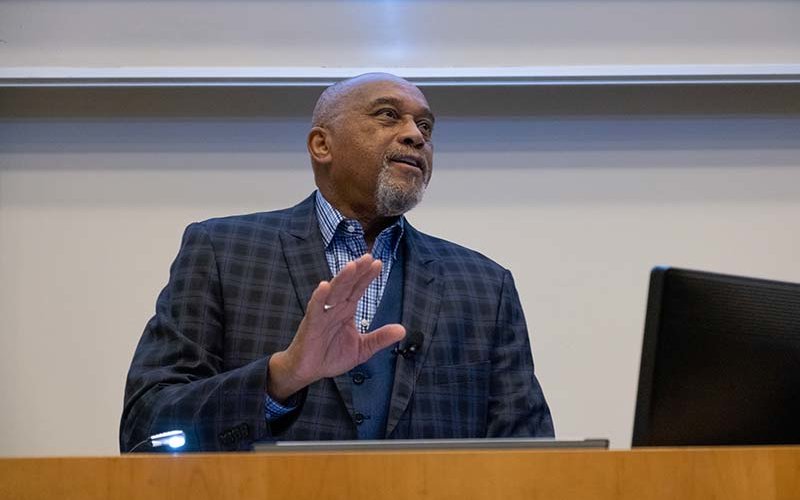
As 120 debate competitors representing schools from 14 states filled a Cal State Fullerton conference room this week, they had the chance to meet and hear from a real American hero. Listening to Tommie Smith’s words, they were inspired to work harder, appreciate the sacrifices of others, and use their talents and skills in pursuit of social justice.
Standing below the iconic image of three Olympic athletes on the winners’ podium, two with raised fists, Smith — the gold medalist in the 1968 Summer Olympics men’s 200-meter race — spoke of his “silent gesture” and the impact of that decision.
That year, the future and power of the civil rights movement was in doubt after the death of Martin Luther King Jr. and Robert Kennedy. Race riots exploded in Detroit. Presidential candidates campaigned on racial segregation.
At the Olympics in Mexico City, two young American athletes walked to the podium to receive their medals following the 200-meter race. The gold medalist was Smith; the bronze medalist was John Carlos. They wore no shoes to protest poverty. They wore a scarf and a necklace to protest lynching. Smith held a box containing an olive branch to symbolize peace. When the national anthem started to play, both athletes raised a gloved fist in protest of ongoing civil rights injustices, primarily in America.
The crowd went silent … and then started to boo. Most of the press was negative or dismissive, especially the sports writers. The athletes were suspended by the U.S. Olympic Committee and expelled from Olympic Village. They came home to death threats.
But that iconic photo of two brave Americans — fists held high, heads bent down — made it to the cover of Life magazine. Sports Illustrated called it “one of the most iconic, important and controversial in sports history.” The Washington Post called it “one of the most influential protest images of all time.” Smith said it was not a black power salute but a human rights salute. All three men, including Australian Peter Norman who won the silver medal, wore “Olympic Project for Human Rights” badges.
Today, half a century later, Smith is viewed as a hero. The Smithsonian Museum of African American History and Culture erected a bronze display of the podium shot and has on display Smith’s shoes, the olive branch box and the track suit he wore that day.
But students attending this week’s CSUF Winter Tournament named for Kathryn Jeanine Congalton did not have to visit the Smithsonian to learn more about this seminal moment.
Smith was on campus to present awards to the debaters, talk about his journey and encourage students to stand up for social justice. Following his success on the track, Smith went to play for the Cincinnati Bengals and eventually served for several years as a professor at Oberlin College in Ohio.
“I am happy to be here, in this moment,” he greeted the debaters. “Today I stand here and wonder where our national conversation will lead us. You have to stand and listen with open optimism. We need to work to achieve unity and you need to put in the work to succeed.
“People have asked me over the years, ‘What was the benefit of raising your fist on that stand?’ I’ll tell you. Fighting for social justice is redemptive. Many see sacrifice as negative, but you need to secure your place to achieve progress.
“If your response to injustice is ‘Oh well,’ that is an outdated thought process. You’ll lose hope. And we cannot afford to believe that hope is obsolete. Creating a safe community is not somebody else’s work. It is YOUR work.
“My silent gesture was my cry for freedom. And we have made progress. But there is still much to be done. You need to be involved. Don’t wallow in despair. Figure out how YOU will be involved.
“As students, you need to work for those A’s. You may have a dream of getting straight A’s, but you’ll need to do more than dream. You’ll need to work. The classroom seats that you are sitting in were paid for by those who came and worked and fought before you. Their sacrifice was made for you.
“You have a responsibility not to give up. You will remember the times when you could have given up but did not.
“I’ll leave you with these four steps: Prepare prayerfully. Plan purposefully. Proceed positively. Pursue persistently.”